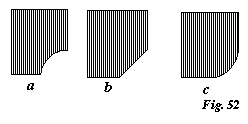DECORATION XXII. THE ANGLE 313
self, finials, and spikes, and I know not what more. But both these conditions are so closely connected with roofs (even the cusp finial being a kind of pendant to a small roof), that I think it better to class them and their ornament under the head of roof decoration, together with the whole tribe of crockets and bosses; so that we shall be here concerned only with the three subjects above distinguished: and, first, the corner or Angle.
§ 7. The mathematician knows there are many kinds of angles; but the one we have principally to deal with now, is that which the reader may very easily conceive as the corner of a square house, or square anything. It is of course the one of most frequent occurrence; and its treatment, once understood, may, with slight modification, be referred to other corners, sharper or blunter, or with curved sides.
§ 8. Evidently the first and 
The first two methods, the most violent and summary, have the apparent disadvantage that we get by them-two corners instead of one; much milder corners, however, and with a different light and shade between them; so that both methods are often very expedient. You may see the straight chamfer (b) on most lamp-posts, and pillars at railway stations, it being the easiest to cut; the concave chamfer requires more care, and occurs generally in well finished but simple architecture,-very beautifully in the small arches of the Broletto of Como, Plate 5; and the straight chamfer
[Version 0.04: March 2008]